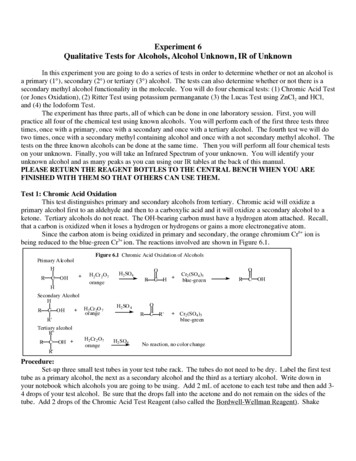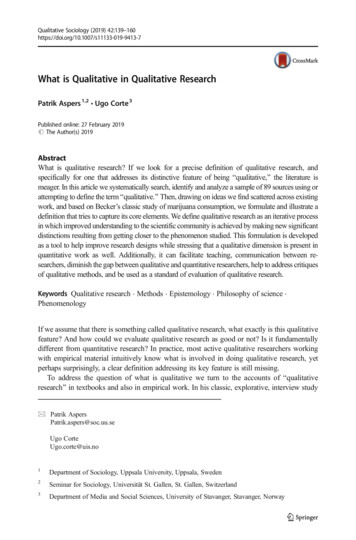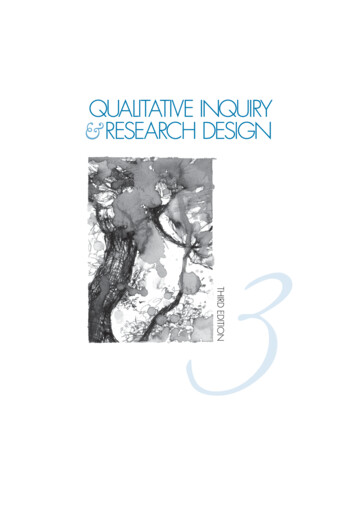
Transcription
Experiment 6Qualitative Tests for Alcohols, Alcohol Unknown, IR of UnknownIn this experiment you are going to do a series of tests in order to determine whether or not an alcohol isa primary (1 ), secondary (2 ) or tertiary (3 ) alcohol. The tests can also determine whether or not there is asecondary methyl alcohol functionality in the molecule. You will do four chemical tests: (1) Chromic Acid Test(or Jones Oxidation), (2) Ritter Test using potassium permanganate (3) the Lucas Test using ZnCl2 and HCl,and (4) the Iodoform Test.The experiment has three parts, all of which can be done in one laboratory session. First, you willpractice all four of the chemical test using known alcohols. You will perform each of the first three tests threetimes, once with a primary, once with a secondary and once with a tertiary alcohol. The fourth test we will dotwo times, once with a secondary methyl containing alcohol and once with a not secondary methyl alcohol. Thetests on the three known alcohols can be done at the same time. Then you will perform all four chemical testson your unknown. Finally, you will take an Infrared Spectrum of your unknown. You will identify yourunknown alcohol and as many peaks as you can using our IR tables at the back of this manual.PLEASE RETURN THE REAGENT BOTTLES TO THE CENTRAL BENCH WHEN YOU AREFINISHED WITH THEM SO THAT OTHERS CAN USE THEM.Test 1: Chromic Acid OxidationThis test distinguishes primary and secondary alcohols from tertiary. Chromic acid will oxidize aprimary alcohol first to an aldehyde and then to a carboxylic acid and it will oxidize a secondary alcohol to aketone. Tertiary alcohols do not react. The OH-bearing carbon must have a hydrogen atom attached. Recall,that a carbon is oxidized when it loses a hydrogen or hydrogens or gains a more electronegative atom.Since the carbon atom is being oxidized in primary and secondary, the orange chromium Cr6 ion isbeing reduced to the blue-green Cr3 ion. The reactions involved are shown in Figure 6.1.Figure 6.1 Chromic Acid Oxidation of AlcoholsPrimary AlcoholHR C OHHSecondary AlcoholHRC OHR'Tertiary alcoholR''R C OH H2 Cr 2 O7orangeH2 Cr 2O 7orangeH2 Cr 2 O7orangeOH2 SO4RCr2 (SO4 )3blue-greenORCOHOH2 SO 4RH2 SO4C H CR' Cr2 (SO4 )3blue-greenNo reaction, no color changeR'Procedure:Set-up three small test tubes in your test tube rack. The tubes do not need to be dry. Label the first testtube as a primary alcohol, the next as a secondary alcohol and the third as a tertiary alcohol. Write down inyour notebook which alcohols you are going to be using. Add 2 mL of acetone to each test tube and then add 34 drops of your test alcohol. Be sure that the drops fall into the acetone and do not remain on the sides of thetube. Add 2 drops of the Chromic Acid Test Reagent (also called the Bordwell-Wellman Reagent). Shake
vigorously using a small, tight fitting cork. You should see a color change to a blue or blue-green or similarlycolored precipitate within a few seconds to indicate a positive test. Record your results in your notebook.Test 2: Ritter TestThis test is similar to the Chromic Acid Oxidation and provides the same information. It is the oxidationof primary and secondary alcohols to carboxylic acids and ketones using potassium permanganate (KMnO4).Again, tertiary alcohols cannot be oxidized by this reagent because there is no hydrogen to be lost from thecarbon that bears the OH group. In the Ritter Test the Mn7 of KMnO4 (bright purple) is reduced to Mn4 . TheMn4 is brownish in color. The reactions involved are as follows.RCH2 OHR 2CHOH R3 COH Figure 6.2 Potassium Permangante OxidationOKMnO4AcOHR C OH or RpurpleKMnO4purpleAcOHOCR MnO2brownNo reaction, no color changeProcedure:As for the Chromic Acid Oxidation, set-up three small, labeled tests tubes. Add 2 mL acetic acid(CAUTION: Stench!) to each tube. Add 3-4 drops of the test alcohol to each tube and then add ONE drop ofsaturated KMnO4 solution to each test tube. Shake vigorously to mix, using a small cork as before. For the 1 and 2 alcohols you should see a brownish color develop as the purple KMnO4 color disappears. Do not add toomuch KMnO4. If you add an excess of this reagent, the purple color will persist even though you have aprimary or secondary alcohol. With the tertiary alcohol you should see no color change since the purple colorremains. Record your observations in your notebook.Test 3: Lucas TestThis test distinguishes tertiary, secondary and primary alcohols from each other. It uses zinc chloride asthe reagent in concentrated hydrochloric acid (Lucas Reagent). It is based on the rate of formation of insolublealkyl chloride. An emulsion is formed. This test is reliable only for alcohols that are fairly soluble in water.Tertiary AlcoholsSecondary AlcoholsPrimary alcoholsReact immediately to form an emulsion of the alkyl halide and water (cloudysolution).React in 5-10 minutes. Heating in warm water and shaking is sometimes necessarywith water-insoluble alcohols.These generally take more than one hour to react.The rate of reaction of the alcohols is determined by the ease of formation of the carbocationintermediate. Tertiary alcohols react quickly because they form a relatively stable tertiary carbocation andsecondary alcohols react more slowly because the secondary carbocation is less stabilized than the tertiarycarbocation.The first step, shown below for a tertiary alcohol, involves a Lewis acid- base reaction between zincchloride and a lone pair of electrons on the alcohol oxygen. In the next step, which is the slow, rate determiningstep, the HO-ZnCl complex leaves and the carbocation is then attacked by a chloride anion from the HClsolvent to form the insoluble alkyl chloride which forms the cloudy emulsion indicative of a positive test.Again, the overall rate of the reaction is determined by the slow step, which is the breaking of the C-OH-ZnClbond. This rate is determined by the stability of the carbocation being formed.
Figure 6.3 Lucas TestTertiary alcoholR''RCR''OH ZnCl2R'Lewis BaseHClRLewis AcidCRRCClCR'-ClR''RCClR'insolubleHRR'R'RCl-HCOR' ZnRecall: Stability of carbocations:R''R''HCHProcedure:Set-up three small test tubes as above, labeling each of them. Add 0.5 mL of the test alcohol to each testtube. To the first test tube, add 3 mL of the Lucas reagent. Shake vigorously using a small cork to stopper thetest tube. Wait at least 10 minutes. If you have a water insoluble alcohol (you see two layers in your test tube)then repeat the experiment using a hot water bath set at 60 C, immersing the test tube in the water bathimmediately after shaking and waiting the 10 minutes with occasional shaking. Also repeat the experimentusing a water-soluble alcohol of the appropriate class. Record your results. Repeat on all three classes ofalcohol.Test 4: Iodoform TestThis test is slightly different from the previous three tests. This test does not distinguish 1 , 2 , 3 alcohol but is specific for only one class of alcohol. This is the secondary methyl alcohol. If the alcoholcontains a methyl group attached to a carbon that also has a hydrogen and an OH group then it will give apositive iodoform test. The formation of a yellow precipitate indicates a positive test. This is shown in figure6.4.Figure 6.4OHRCHCH3R H, CH3 , CH 2CH3, etcThis group must be present inthe molecule in order to give apositive iodoform test.The mechanism of the reaction is somewhat complex (Figure 6.5) and will be studied in detail in thesecond semester. Only the outline of the mechanism is shown here. Notice that the first step is the formation ofthe mild oxidizing agent sodium hypoiodite, NaOI, from sodium hydroxide and iodine. NaOI oxidizes thealcohol to a carbonyl in the second step. NaOI is similar to sodium hypochlorite, NaOCl, which is the activeingredient in household bleach. Notice that the oxidation state of the halogen is 1, not the usual –1. In thesecond step, the alcohol is oxidized to a ketone (loss of two hydrogens) and the oxidation state of the iodinechanges from 1 to –1 (gain of 2 electrons). In the third step, which really consists of several individual steps,the methyl ketone is converted to the anion of a carboxylic acid (with one carbon less than the alcohol) andiodoform (yellow precipitate). Only the second and third steps involve oxidation/reduction.
Note that the initial product formed is a methyl ketone derivative and acetone contains this functionality.Acetone therefore gives a positive Iodoform Test. Be sure that your test tube does not contain any traces ofacetone.Figure 6.5 Iodoform TestNa -I I Na - OHIStep 1:IOOHStep 2:RCCH3 IO- Na RHCCCH3 H2 O I-OOStep 3: RO- Na CH3 3 I2 4 HO-RCO- CHI3 3 H2 O Iodoform yellow solid3I-Procedure:We will do the iodoform test only twice with known alcohols, once with an alcohol that contains themethyl secondary alcohol functionality and once with a compound that does not. You will need two mediumsized test tubes. Make sure there is no acetone present in your test tubes. Acetone also gives a positiveIodoform Test.To each test tube, add 4-5 drops of test alcohol, 2 mL H2O, 2 mL 10% sodium hydroxide solution. Ifyour alcohol does not fully dissolve, add 1 mL of ethanol.Add a 10% solution of iodine (I2) in potassium iodide (KI) dropwise. Keep adding the dark iodinesolution with stirring until you see a faint yellow color persisting in the test tube. Note the reaction that isoccurring. As you add the I2 to the NaOH solution, you are forming your sodium hypoiodite reagent. Addenough iodine so that you have a slight excess of iodine as evidenced by a persistent yellow or brownish color.You should see a yellow precipitate starting to form within five minutes. Sometimes you may need toheat the mixture to 60 C in a water bath.Unknown AlcoholWhen you have finished all four tests and are confident that you can perform them accurately and candistinguish a positive test from a negative one, then get an unknown alcohol from the teaching assistant. Recordyour unknown number in your notebook and then repeat all four tests on your unknown. Your goal is toclassify it as a primary, secondary or tertiary alcohol.Record the results of the four tests in your notebook and on your Unknown Report Sheet.Infrared Spectrum of Your UnknownOnce you have identified your unknown as a 1 , 2 , or 3 alcohol, then you will also take its infra-redspectrum to establish its identity. Place the spectrum in your laboratory notebook and identify as manyabsorbances as you can using the IR correlation table given at the back of this manual and in the textbook.Positive identification can be made by comparing your spectrum to that of the authentic alcohol. These aregiven in Appendix 6.2. Another source is of spectra is http://webbook.nist.gov/gov/chemistry. The NationalInstitute of Standards and Technology (NIST) provides gas-phase spectra and the absorbances due to the O-Hstretching frequency will be much narrower and at higher wavenumbers (cm-1). Why? The rest of the spectrumwill be very similar to that of the liquid phase.***************************
Appendix 6.1: A possible mechanism for hypoiodite oxidation of Alcohols.Figure 6.6IIOHRC CH3 HIOH -I Na - OHRNa IHHIIOC CH3 -OHROHOOC CH3H-Appendix 6.2 Infrared Spectra of Unknown Alcohols.Methyl AlcoholEthyl AlcoholOHRC CH3 I- H2 O
1-Propanol2-methyl-2-Propanol1-Butanol
2-Butanol (s-Butyl Alcohol)1-Pentanol (Amyl Alcohol)3-Methyl-1-butanol (Isoamyl Alcohol)
2-Methyl-2-butanolCyclohexanol
In this experiment you are going to do a series of tests in order to determine whether or not an alcohol is a primary (1 ), secondary (2 ) or tertiary (3 ) alcohol. The tests can also determine whether or not there is a secondary methyl alcohol functionality in the molecule. You will do four chemical tests: (1) Chromic Acid Test










